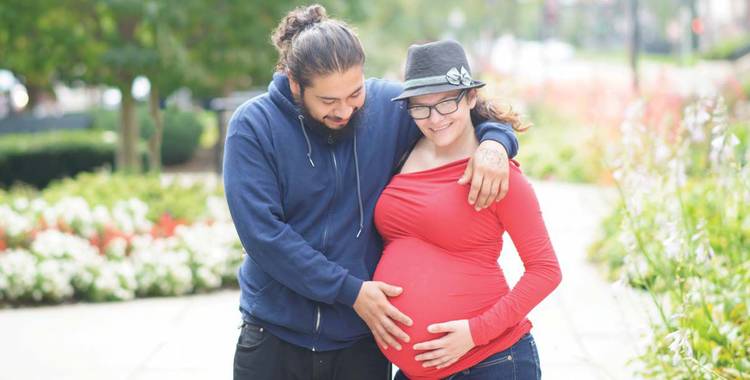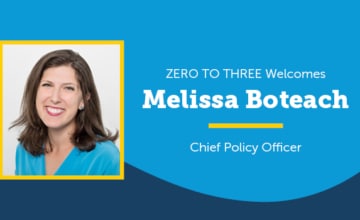Rebecca Parlakian and Kathy Kinsner, ZERO TO THREE, Washington, DC

Abstract
This article reviews the research base on the development of prenatal attachment and profiles four programs that foster this essential prenatal relationship: CenteringPregnancy®, the Practical Resources for Effective Postpartum Parenting program (PREPP), Mindfulness-Based Childbirth and Parenting (MBCP), and Moms2B.
While many people may understand prenatal attachment intuitively—expectant parents responding to fetal movements, attributing individual personal qualities to the growing fetus, engaging in nurturing, health-positive behaviors to support a healthy pregnancy—the elements of prenatal attachment are still being mapped by research. Understanding the currently known risk and protective factors contributing to prenatal attachment can help to maximize healthy outcomes for both mother and baby, both in the short-term and across the lifespan. Here, we provide a brief introduction to prenatal attachment and profile four programs that have intentionally and thoughtfully designed services for expectant families that nurture this critical, sometimes fragile, growing relationship between parent and fetus.
What Is Prenatal Attachment?
Brandon and colleagues (Brandon, Pitts, Denton, Stringer, & Evans, 2009) wrote that the concept of prenatal attachment surfaced as early as the 1950s, when three theorists, Helene Deutch, Grete Bibring, and Therese Benedek, described it as a process in which a pregnant woman becomes emotionally invested in her fetus. More formal definitions evolved over the next two decades and were strongly influenced by the research of nurses working in maternity care. Mecca Cranley, a nursing graduate student, is often credited with the first formal definition of maternal fetal attachment: “The extent to which women engage in behaviors that represent an affiliation and interaction with their unborn child” (cited in Brandon, et al., 2009). In 2003, Doan and Zimmerman offered an expanded perspective, describing prenatal attachment as an “affiliative relationship between parent and fetus … related to cognitive and emotional abilities to conceptualize another human being” that develops within an ecological system (cited in Brandon et al., 2009).
Tools to Measure Prenatal Attachment
In 1981, Cranley developed a Maternal Fetal Attachment Scale (MFAS) that quantified aspects of prenatal attachment previously assessed through self-report questionnaires. A modified version of the scale is still in use today. In 1993, Australian researcher John Condon developed a Maternal Antenatal Attachment Scale that measures two aspects of prenatal attachment, “quality” and “intensity” (Brandon et al., 2009). “Quality” describes the affective experiences the mother may report such as closeness/distance, tenderness/ irritation, pleasure in interaction, distress at fantasized loss, and conceptualization of the fetus as a “little person.” “Intensity” refers to the amount of time the mother reports thinking about, talking to, dreaming about the baby, or touching/rubbing her stomach. On both subscales, higher scores reflect a positive quality of attachment (Pisoni et al., 2014). Condon’s scale is in common use today.
Why Is Prenatal Attachment Important?
Several studies have found that the quality of the parent–fetus relationship (prenatal attachment) is related to the quality of the parent–infant relationship (Alhusen, 2008). The assumption is that a parent’s sense of connection in the prenatal period influences their daily interactions and caregiving once the baby is born, shaping the quality of their relationship and their attachment status. Research has established that a secure attachment confers many short- and long-term benefits on the child, including better cognitive outcomes and better social interactions (Sroufe, 2005), as well as contributing to the development of empathy (Murphy & Laible, 2013). Prenatal attachment may represent an important opportunity to help families establish the early, healthy relationships that are associated with positive outcomes across the child’s lifespan. In short, research indicates that “at the very least, [maternal fetal attachment] is a forerunner of mother-infant attachment” (Brandon et al., 2009).
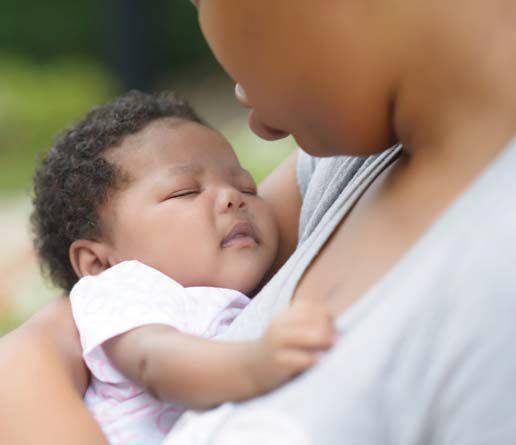
Understanding the currently known risk and protective factors contributing to prenatal attachment can help to maximize healthy outcomes for both mother and baby.
What Does Prenatal Attachment Look Like?
The frequency and intensity of prenatal attachment behaviors increase with advancing gestational age, particularly after approximately 18 to 22 weeks of gestation (Salisbury, Law, LaGasse, & Lester, 2003). Prenatal attachment is manifested in behaviors that demonstrate care and commitment to the fetus and include health-promoting behaviors (e.g., eating well, abstaining from harmful substances, such as alcohol), nurturance (e.g., stroking the belly), and physical preparation (e.g., buying baby clothes and equipment; Salisbury, et al., 2003). These behaviors both prepare the expectant mother for parenthood and support the healthy development of the baby. Prenatal attachment appears to be influenced by factors including the amount of fetal movement, pregnancy history (increased parity, or the number of pregnancies reaching viable gestational age including live births and stillbirths) tends to correlate with decreased prenatal attachment; Cranley, 1981), and the mother’s own attachment history (Lerum & LoBiondo-Wood, 1989). Research suggests robust generational correlation between attachment styles. Securely attached parents tend to raise securely attached babies; insecurely attached parents tend to experience insecurely attached babies (Brandon et al., 2009).
What Factors May Interrupt Prenatal Attachment?
The expectant mother’s mental health also plays a significant role in the process of prenatal attachment. Maternal mood, and particularly maternal depression during pregnancy, has been negatively associated with prenatal attachment and related to poor prenatal health in general (including poor weight gain, substance use, and smoking; Lindgren, 2001; Zuckerman et al., 1989). Hart and McMahon examined the impact of depression and anxiety on prenatal attachment and found that women characterized as having a low quality of fetal attachment reported significantly higher levels of anxiety and depression (2006). While this study represents a correlational, not causal, relationship, an expectant mother’s mental health may certainly contribute to a healthy pregnancy.
Experiencing interpersonal trauma also appears to interrupt the process of prenatal attachment (Schwerdtfeger & Goff, 2007), as does experiencing an unplanned pregnancy (Damato, 2004). Taking a trauma-informed approach to care and connecting mothers to needed mental health services as early as possible during pregnancy may help to support mother–child relationships after birth.
Interventions to Support Prenatal Attachment
For mothers at risk of not establishing a strong prenatal attachment, there are opportunities to intervene and shift the family’s trajectory. In addition to supporting mothers in accessing needed mental health services, there are other levers that professionals might use to circle an expectant mother with nurturance. For example, social support of family members and peers is a significant predictor of prenatal attachment (Salisbury et al., 2003). Perceived support of prenatal care providers was also positively correlated with prenatal attachment, providing evidence that psychosocial support is a critical component of prenatal care (Cranley, 1984).
When professionals are able to identify expectant parents at risk for attachment difficulties, there is an opportunity to intervene early to disrupt this generational pattern. Following are the stories of how four programs for parents-to-be are addressing, and supporting, prenatal attachment in communities across the United States.
CenteringPregnancy®
More than 25 years ago, Sharon Schindler Rising, a certified nurse midwife, developed CenteringPregnancy out of frustration with traditional prenatal care. She found herself addressing the same questions with patient after patient, with little time for deeper conversations about the information parents-to-be really needed. She decided to bring patients with similar due dates together in a group prenatal visit to give them an opportunity to learn from her and from one another.
That was in 1993. In the intervening years, CenteringPregnancy has expanded to more than 580 locations in 46 states, and now serves 70,000 patients annually.
The CenteringPregnancy Intervention
The Centering model is evidence-based and combines health assessment, interactive learning, and community building to help support positive health behaviors and drive better health outcomes. It brings patients out of the exam room and into a group setting which also helps build their community of support.
CenteringPregnancy follows the American College of Obstetricians and Gynecologists’ schedule for prenatal visits, replacing individual appointments with group gatherings of mothers-to-be and their partners or support people. Each visit is 90 minutes to 2 hours long, giving women much more time with their health care providers than individual visits allow. The CenteringPregnancy model empowers patients, strengthens patient–provider relationships, and builds communities through three main components:
- Health Assessment. Visits begin with self-assessments and the clinical health assessment. Participants are trained to monitor and record their own weight and blood pressure, and they have individual time with their provider for the routine exam. There’s also music, food, and socializing during this time, allowing moms-to-be to strengthen their bonds as a learning community.
- Interactive Learning. After the health assessments are finished, participants circle up for 1½ hours of educational content. Although there is planned content for every visit, the group explores the topics that matter most to the participants. Marena Burnett, Senior Director of Engagement and Innovation, explains: “Information is shared in a way that is accessible, understood, and retained by the participants. This experiential learning can lead to greater health literacy, behavior change, and empowerment.” Burnett continues, “We see that many of the participants have the same questions and learn from one another’s experiences. The provider and staff facilitators are trained to encourage that peer support and will correct misinformation, as needed. Often they don’t even need to correct misinformation because other parents jump in to provide the accurate information.”
- Community Building. Patients quickly find comfort and support in knowing they are not alone. Participation in group care lessens the feelings of isolation and stress while building friendships, community, and support systems. Increasingly, parents can continue receiving pediatric care for their children through the CenteringParenting model following the birth of their babies to the second birthday.
Lynn Scheidenhelm, LCSW, Director of Innovation and Centering Consultant, describes the importance of attachment in the 10-session curriculum: “Early on, we talk about how moms are feeling about the pregnancy and the environmental factors that affect attachment. We facilitate discussion related to early prenatal and postpartum stress management, including relaxation and mindfulness.” She reports that expectant moms vary widely in the meaning they assign to events. “You can hear ‘my baby is kicking me because he’s mad at me.’ versus ‘I can feel the baby moving around and I can’t wait to meet him.’ comments in the group,” she says. “Other moms in the group often validate an expectant mother’s stress or worry and offer support around what’s normal and how to manage.”
Evaluation and Future Directions
There have been more than 120 peer-reviewed articles on the CenteringPregnancy intervention, and studies have shown that mothers who participate give birth to babies with higher birth weights, and they experience decreased rates of postpartum depression, a decreased risk of preterm birth, and higher rates of breastfeeding. In practices that use CenteringPregnancy, there is a flattening of racial disparities with preterm birth rates. Participants also report higher rates of patient satisfaction, and providers describe the model as fun and re-energizing.
A recent grant is enabling Centering Healthcare Institute to offer implementation support and facilitation training to 130 eligible sites—primarily in Federally Qualified Healthcare Centers and community health centers—eliminating the financial barrier to those in resource-limited communities. The grant requires that sites offer both the CenteringPregnancy and CenteringParenting programs to provide continuity of care and support from pregnancy through the child’s early years of life.
Practice Resources for Effective Postpartum Parenting (PREPP)
PREPP grew out of work being done by the Perinatal Pathways Lab at Columbia University (New York, NY), which is focused on exploring the impact of pregnant women’s distress on fetal and infant brain–behavior development. The goal of PREPP is to prevent postpartum depression and the negative effects it has on women and their families through an intervention that targets the mother–infant dyad during pregnancy and postpartum.
The PREPP Intervention
PREPP is a five-session intervention, beginning at the start of the third trimester and continuing through 6 weeks’ postpartum. Sessions are delivered one-on-one with a mental health clinician, called a PREPP coach, through a combination of in-person visits and phone calls.
In the first session, the PREPP coach begins to explore the development of a parental identity (“Who will I be as a parent?”), encourages the mother’s image-making of the baby (“Who will this baby be?”), and begins to reflect with the mother on her own childhood. Specifically, coaches offer mothers the opportunity to consider the elements of their upbringing that they would like to repeat with their own children and what practices they would like to leave behind. Dr. Elizabeth Werner, who co-developed the PREPP program with Dr. Catherine Monk and is currently the program’s Lead Supervising Clinician, notes that this session may be the first time mothers have had someone ask them about these issues, particularly their own histories. She explains that it is “powerful” for mothers to “create some distance” between the past and present and consciously “make the decision to do something differently.” This simple act can initiate a mother’s early sense of attachment and connection to her baby. Another important focus of this first session is teaching mothers basic sleep hygiene skills and introducing them to mindfulness meditation as a strategy to reduce stress and distress.
In the second PREPP session, coaches review mindfulness skills and talk with mothers about important people in their lives who will be providers of support in the postpartum period and how to engage those people in ways that help them to feel supported. The primary focus of this session is teaching mothers a set of skills to help babies sleep more and cry less. This session also introduces a set of psychoeducational skills— helping expectant mothers reflect on how they will feel and how the baby will likely behave and interact in the postpartum period. For example, coaches draw and explain the crying curve, normalizing the crying pattern of babies from 2 weeks to 5 months old. These discussions are designed to give women a sense of mastery and confidence in their parenting, reduce maternal distress in the weeks following birth, and support enjoyment of their baby’s early infancy.
New mothers receive phone calls shortly after birth and at 2 weeks postpartum, with the final in-person session taking place 6 weeks postpartum. The 6-week mark is an important point in the postpartum period as newborns are nearing the peak of crying (2 months), and it is around this time when depression or anxiety typically begins to set in for the mother. During this session, coaches explore how the transition to motherhood is going and ask about mothers’ physical and emotional health.
Evaluation and Future Directions
PREPP has launched a large-scale evaluation of the program’s outcomes involving 300 enrolled women. Participation in the study is being offered to any woman who plans to deliver at Columbia University Medical Center, including both the Medicaid clinic and private practice clinics. Previous, smaller-scale evaluations have found that PREPP reduced the rate of severe postpartum depression for women at risk for it and that a mother’s participation in the PREPP program was associated with less infant crying at 6 weeks postpartum.
PREPP is designed to occur at the same time as obstetric appointments during pregnancy—making it more accessible to women and reducing mental health care stigma, and its developers would like to see it become part of the standard of care. Because expectant mothers are already motivated to attend prenatal visits with their obstetrician, offering PREPP more widely in these settings would give many more women the chance to process the impact of their own histories and—most importantly—disrupt the generational transmission of trauma.
Mindfulness-Based Childbirth and Parenting (MBCP)
MBCP is a childbirth preparation program adapted from Mindfulness-Based Stress Reduction by Nancy Bardacke, a certified nurse midwife. The MBCP course applies training in mindfulness—the intentional turning toward present-moment experience as it unfolds—to the experience of pregnancy and early parenting (Bardacke, 2012). The goal of MBCP is to help expectant women and their partners learn how to use mindfulness strategies to cope with anxiety, pain, and stress in pregnancy and during childbirth, as well as with the challenges of parenting an infant (Duncan & Shaddix, 2015). MBCP’s curriculum is designed to cultivate a healthy connection with the baby, co-parent, and the broader community that develops among participating families.
The MBCP Intervention
MBCP is 9 weeks in length, with a mindfulness meditation retreat between weeks 6 and 7 and an additional reunion gathering after all women have given birth. Typically, expectant parents start the program in the late second (or early third) trimester of pregnancy. Pregnant women and their partners are encouraged to attend together. Each class is 3 hours in length and includes instruction in childbirth-related topics as well as instruction in mindfulness meditation practices—which range from body scans, to mindful yoga, to guided sitting meditations. The mindfulness activities include opportunities for participants to notice and attend to the changing mental and physical landscape of pregnancy, such as taking note of fetal movements during the body scan (Duncan & Shaddix, 2015).
Other topics included in the curriculum are pain management strategies, an introduction to breastfeeding, and adjusting to life with a newborn (including the baby’s social, emotional, and biological needs). Mindfulness practices are threaded throughout all topics—for example, walking meditation is suggested as a strategy to soothe a crying baby. The “loving kindness” practice is also taught and used to cultivate a sense of connection between the mother and baby, and between the mother and other important people in her life (e.g., co-parent, peers in the group).
University of Illinois’ Dr. Heidemarie Laurent, a clinical-community psychology researcher who has also completed training in MBCP, emphasizes that the skills learned within the MBCP program are meant to extend beyond the one significant event of childbirth: “Learning to work with pain and difficulty is part of birthing a child, but will carry over— and perhaps be more important—in the time after the child is born.” MBCP refers to these difficult parenting and life challenges as “contractions of life” and encourages parents to apply the skills learned in MBCP to move through these experiences successfully.
Evaluation and Future Directions
An evaluation of MBCP found statistically significant increases in mindfulness and positive affect among participants, as well as decreases in pregnancy anxiety, depression, and negative affect (Duncan & Bardacke, 2010). Dr. Laurent noted that studies done within her program using pre/post measures have found reductions in depression and anxiety in both expectant women and their partners and increases in parent reports of a strong “bond” with the baby.
Dr. Laurent’s team at the University of Illinois was recently funded for a 2-year study of MBCP’s effects on 60 expectant mothers through a randomized controlled trial. This support allows researchers to offer the program at no cost, in order to make it accessible and useful to expectant families from all backgrounds. This study will move beyond self-report measures of maternal mental health and bonding with the baby to test effects of MBCP on brain responsiveness to the baby during both playful/positive and challenging/negative emotional situations.
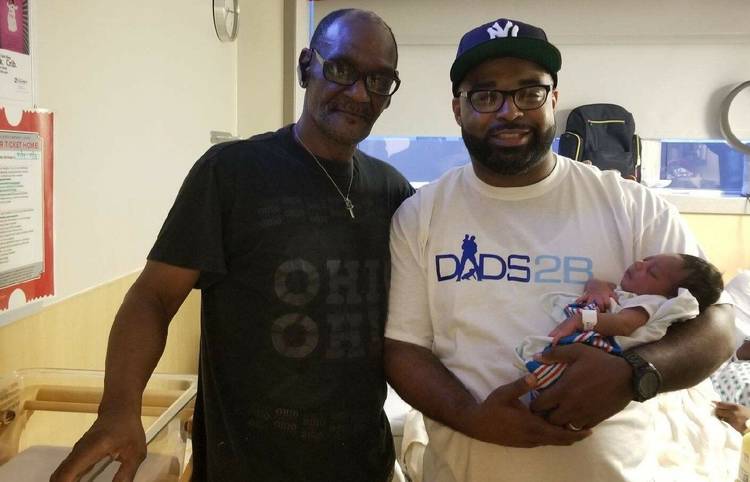
Expectant moms are invited to bring a support person, and there’s a male staff member on the Moms2B team who makes sure the dads feel welcome and understood.
Moms2B
Moms2B began in a church basement 8 years ago, with its founder, its director, and two expectant mothers at its first meeting. Ohio currently ranks 39th in infant mortality, and the Weinland Park neighborhood in Columbus had some of the highest infant mortality rates in the state: 6 babies died between birth and their first birthday in the 3 years before the program began (an infant mortality rate of 14.2 per 1,000). When she heard those statistics, Twinkle Schottke, director and infant mental health specialist, remembers thinking, “…we can’t let people die in this neighborhood.” Schottke and Moms2B’s founder, pediatrician Pat Gabbe, developed Moms2B as a flexible weekly program. To encourage participation, Moms2B has no eligibility criteria and an open-door policy—with the goal that moms-to-be “never want to leave.” Growing on a word-of-mouth basis, Moms2B currently sees 110 women a week at eight locations around Columbus. In fact, 80% of enrolled mothers have been referred by others in the program, the result of the now-8-year-old invitation to “come back and bring a friend.” Even better, the program has achieved its early goals of nurturing healthy development for babies in the community: A study 4 years after the program’s launch found there were no infant deaths among Moms2B participants (Gabbe et al., 2017).
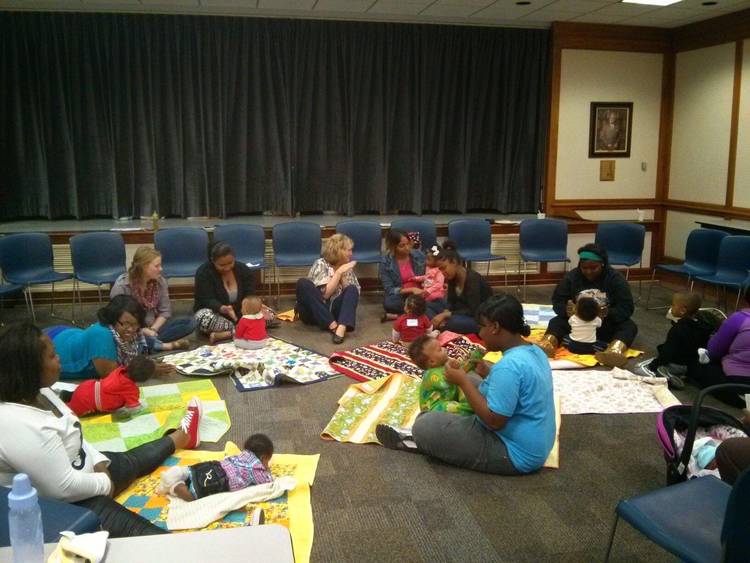
In a meeting for parents who have already given birth, there’s a lot of laughter, even more questions, and introductions that signal pride in their commitment to the program: “I have three children, and my youngest is a Moms2B baby.”
The Moms2B Intervention
At Moms2B, prenatal attachment begins with facilitators building a relationship with each expectant mom. For many expectant mothers in the program, the experience of being cared for by someone else is new. One mom describes Moms2B meetings as a place where she feels “loved.”
Expectant mothers enter the program at various stages of pregnancy and attend for different lengths of time; they are encouraged to remain in the program until their baby’s first birthday. Moms2B serves a diverse population, ranging from urban Columbus to rural Appalachia, including expectant mothers from their young teens through their late 40s.
The program’s motto is CPR—consistency, predictability, responsibility. Meetings are held at the same time and place every week, and each session follows a similar pattern. Moms2B meetings cover topics ranging from breastfeeding to smoking cessation, with plenty of opportunity for participants to ask questions and offer their own insights. Every meeting begins with a Sister Circle, in which new participants are welcomed and all who are present—clients, staff, and visitors— address the question of the day, for example, describing someone they view as a role model. Next, there are three brief presentations, each supported by a single-page daily information sheet developed specifically for this program and updated frequently to reflect current research. For example, one week’s agenda includes information about the benefits of mental health counseling, vitamin and mineral supplements for breastfeeding moms, and family budgeting.
There is a strong emphasis on the growing parent–child relationship. Moms introduce themselves by describing how many weeks pregnant they are and whether they’re expecting a boy or girl. Ultrasound photos are proudly passed among participants, with facilitators observing and pointing out behaviors (like touching or rubbing the belly) that validate the growing connection between mother and baby. The curriculum also addresses important aspects of attachment, such as understanding and responding to a young baby’s cues. The emphasis in every Moms2B meeting is the belief that, as Schottke shares, “Everybody wants to be the best parent they can, but sometimes they just don’t know how to get there.”
Evaluation and Future Directions
The results of a randomized control trial of the Moms2B program were expected in March 2019 and Schottke is working on several grants that will allow the program to expand beyond the Columbus area.
Conclusion
There is much talk recently about the importance of “twogeneration” interventions, but little acknowledgment that these efforts should, in fact, begin during pregnancy (before the second generation is born!). Services provided across these 9 months of preparation and anticipation are integral to interrupting transgenerational trauma and building strong, healthy families from the start. Supports offered in the prenatal period help expectant families develop the knowledge and skills they need to build strong relationships with their children—the secure attachments that, research shows, offer dividends across a child’s lifespan. Although approaches may vary depending on local culture and preferences, what remains a constant across all of the programs profiled in this article is a commitment to keeping expectant parents at the heart of services—ensuring their needs are met so they are able and prepared to meet their children’s needs.
Learn More
CenteringPregnancy® Source link
Practice Resources for Effective Postpartum Parenting (PREPP) Source link
Mindfulness-Based Childbirth and Parenting Source link
Moms2B Source link
About the Authors
Rebecca Parlakian, MEd, serves as senior director of programs at ZERO TO THREE, where she directs a portfolio of projects related to child development, parenting, and high-quality teaching/caregiving. Rebecca has co-authored three parenting curricula and developed parenting resources in various formats (e.g., app, podcasts, web resources, and videos). Rebecca holds a master’s degree from the George Washington University in early childhood special education.
Kathy Kinsner, MEd, is ZERO TO THREE’s senior manager of parenting resources. She has worked as a teacher, a kids’ TV producer (3 Emmys and an NAACP Image Award), and a creator of educational materials for parents, teachers, and children. Kathy is passionate about education equity and enjoys developing video and print resources that make research accessible to every audience. She holds master’s degrees in education (Bowling Green State University) and TV, radio, and film (Syracuse).
Suggested Citation
Parlakian, R., & Kinsner, K. (2019). Early connections last a lifetime: Four programs focused on supporting prenatal attachment. ZERO TO THREE Journal, 39(5), 15–21.
References
Alhusen, J. L. (2008). A literature update on maternal–fetal attachment. Journal of Obstetric, Gynecologic & Neonatal Nursing, 37, 315–28.
Bardacke, N. (2012). Mindful birthing: Training the mind, body, and heart for childbirth and beyond. New York, NY: HarperOne.
Brandon, A. R., Pitts, S., Denton, W. H., Stringer, C. A., & Evans, H. M (2009). A history of the theory of prenatal attachment. Source link
Cranley, M. S. (1981). Development of a tool for the measurement of maternal attachment during pregnancy. Nursing Research, 30(5), 281–284.
Cranley, M. S. (1984). Social support as a factor in the development of parents’ attachment to their unborn. Birth Defects Original Article Series, 20, 99–124.
Damato, E. G. (2004). Prenatal attachment and other correlates of postnatal maternal attachment to twins. Advances in Neonatal Care, 4(5), 274–291.
Duncan, L. G., & Bardacke, N. (2010). Mindfulness-based childbirth and parenting education: Promoting family mindfulness during the perinatal period. Journal of Child and Family Studies, 19(2), 190–202.
Duncan, L. G., & Shaddix, C. (2015). Mindfulness-Based Childbirth and Parenting (MBCP): Innovation in birth preparation to support healthy, happy families. International Journal of Birth and Parent Education, 2(2), 30–33.
Gabbe, P., Reno, P., Clutter, C., Schottke, T. F., Price, T., Calhoun, K., Sager, J., & Lynch, C. D. (2017). Improving maternal and infant child health outcomes with community-based pregnancy support groups: Outcomes from Moms2B Ohio. Maternal and Child Health Journal, 21(5), 1130–1138.
Hart, R., & McMahon, C. A. (2006). Mood state and psychological adjustment to pregnancy. Archives of Women’s Mental Health, 9(6), 329–337.
Lerum, C. W., & LoBiondo-Wood, G. (1989). The relationship of maternal age, quickening, and physical symptoms of pregnancy to the development of maternal-fetal attachment. Birth, 16, 13–17.
Lindgren, K. (2001). Relationships among maternal-fetal attachment, prenatal depression, and health practices in pregnancy. Research in Nursing & Health, 24, 203–217.
Murphy, T. P., & Laible, D. J. (2013). The influence of attachment security on preschool children’s empathic concern. International Journal of Behavioral Development, 37(5),436–440 .
Pisoni, C., Garofoli, F., Tzialla, C., Orcesi, S., Spinillo, A., Politi, P., … Stronati, M. (2014). Risk and protective factors in maternal-fetal attachment development. Early Human Development, 90S2, S45–S46.
Salisbury, A., Law, K., LaGasse, L., & Lester, B. (2003). Maternal-fetal attachment. JAMA, 289(13), 1701.
Schwerdtfeger, K. L., & Goff, B. S. (2007). Intergenerational transmission of trauma: Exploring mother-infant prenatal attachment. Journal of Traumatic Stress, 20(1), 39–51.
Sroufe, L. A. (2005). Attachment and development: A prospective, longitudinal study from birth to adulthood. Attachment & Human Development, 7(4), 349–367.
Zuckerman. B., Frank D. A., Hingson, R., Amaro, H., Levenson, S. M., Kayne, H.,… Bauchner, H. (1989). Effects of maternal marijuana and cocaine use on fetal growth. New England Journal of Medicine, 320, 762–768.

